12 Best Marketing Analytics Platforms for 2026 [According to Real Users]

12 Best Marketing Analytics Platforms for 2026 [According to Real Users]
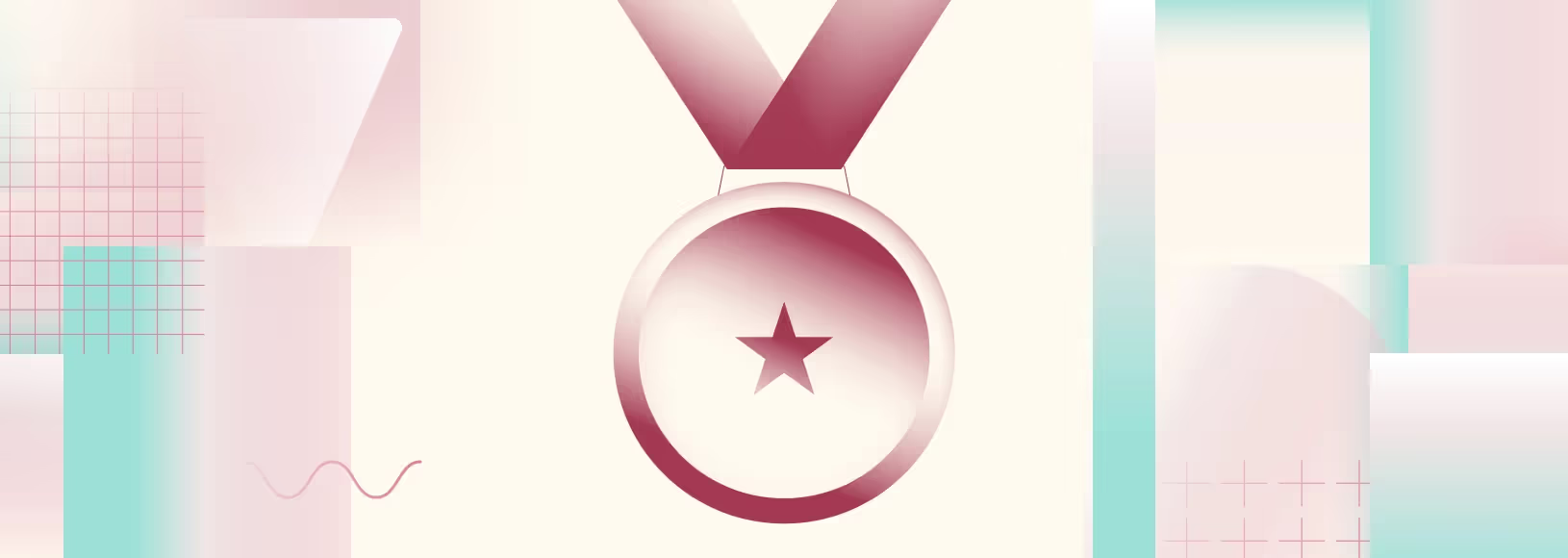
Traditional marketing analytics platforms just don’t cut it anymore.
With customer behavior getting more sophisticated, data pouring in from countless channels, third-party cookie bans, and data privacy regulations tightening, these tools simply aren’t equipped to handle the complexity.
At the end of the day, marketers are left piecing together fragmented insights and guessing at what’s really driving results.
Luckily, there’s a better way to get the clarity you need.
We’ve handpicked 12 of the best marketing analytics platforms currently on the market – whether you’re after deeper insights, stronger privacy features, or just tired of manual data crunching, you’ll find the perfect fit here.
Key Features to Look for in Marketing Analytics Tools
When evaluating top marketing analytics tools, here are some key features and functionalities to look for:
- Data integration: The tool should seamlessly connect to all your key data sources (ads, web analytics, CRM, email marketing, etc.), pulling in granular data for detailed analysis. Look for platforms that offer API access for custom integrations and ensure data quality with built-in cleaning.
- Data visualization: You want a tool that has a variety of visualization options, from charts and graphs to interactive maps.
- Customizable reporting: Your team needs to see the metrics that matter to them, not just generic templates. Look for flexible report builders and customizable dashboards that allow users to easily track their specific KPIs and visualize funnel performance without needing technical help.
- Attribution modeling: Basic models like last-touch are useless for understanding the real customer journey. Demand a platform that supports multiple multi-touch attribution models (linear, U-shaped, W-shaped, custom) so you can analyze how different touchpoints influence conversion rates and revenue.
- AI-powered analysis & predictive analytics: Modern platforms should do more than just report historical data. Look for AI-powered functionalities to proactively surface insights, identify anomalies, and even offer predictive analytics features to help you make more informed decisions about future campaigns.
- User-friendly interface: The most powerful analytics are useless if your team can't easily navigate the platform. Prioritize an intuitive interface and good onboarding support.
- Scalability: Ensure the platform is scalable and can handle growing data volumes as your business expands, ideally being a cloud-based solution for flexibility.
- Collaboration features: Look for tools that allow data sharing, commenting, and annotations to improve collaboration across remote teams and departments.
- Automates actions & workflows: Look beyond just reporting. Does the platform allow you to automate marketing workflows based on the insights? Can it trigger alerts or actions in other tools? The goal is analytics that lead directly to action, improving efficiency and the overall user experience.
Top Marketing Analytics Software to Consider
Alright, you know what features actually matter. Now, let's see which platforms stack up and which ones are just expensive dashboards full of vanity metrics.
We've categorized the top players on the market based on what they actually do, so you can cut through the vendor hype and find the right engine for your GTM team.
Here are the platforms we'll cover:
- HockeyStack
- Ruler Analytics
- Google Analytics 4
- Matomo
- Mixpanel
- Amplitude Analytics
- HubSpot Marketing Hub
- Salesforce Marketing Cloud Intelligence
- Tableau
- Domo
- Semrush
- Sprout Social
GTM Intelligence & Revenue Attribution Platforms
These platforms focus on unifying data from various sales and marketing sources to connect GTM activities directly to pipeline and revenue outcomes. Their primary goal is to provide accurate revenue attribution and a clear understanding of marketing ROI by analyzing the full customer journey.
1. HockeyStack
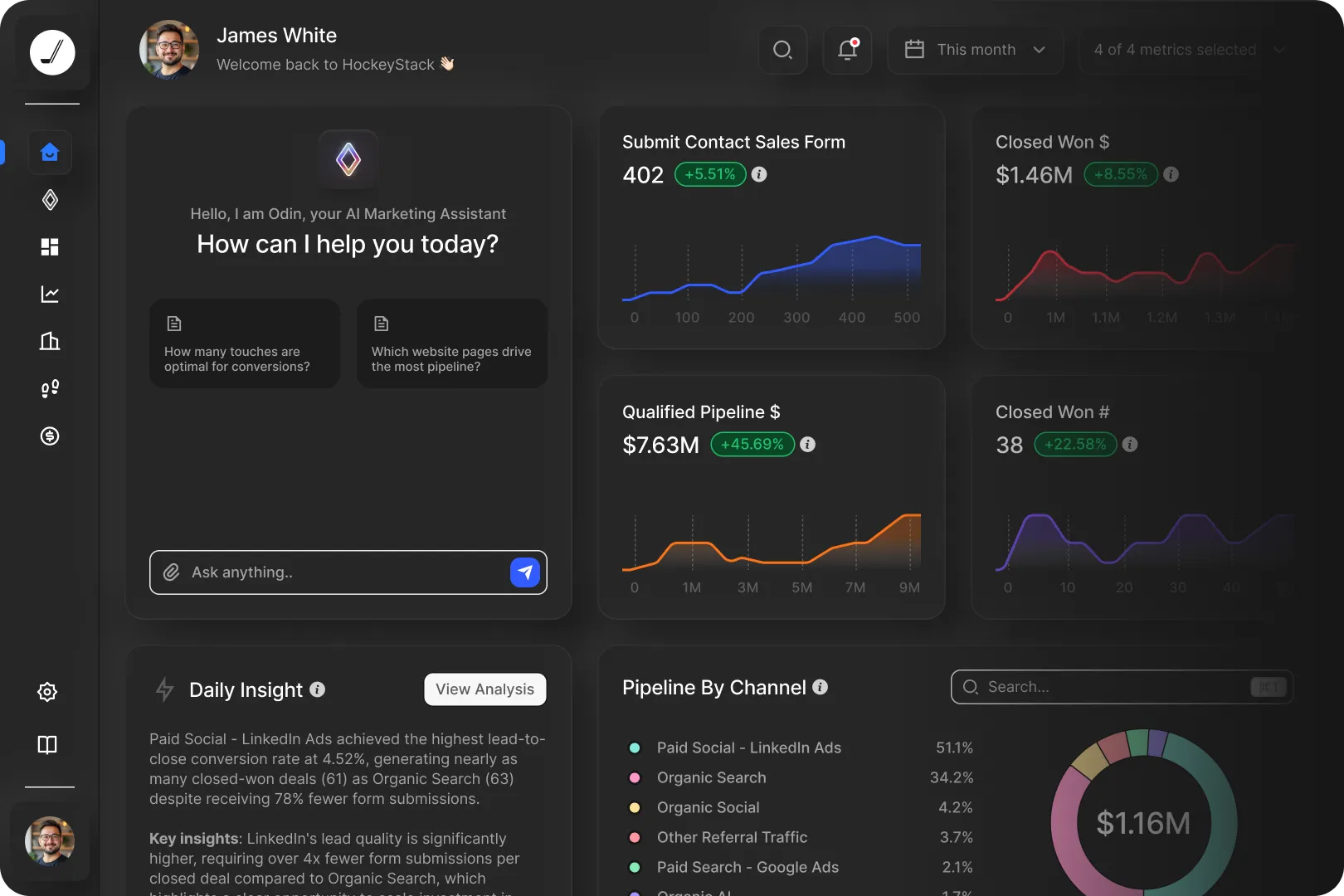
HockeyStack is a GTM intelligence platform that provides a comprehensive suite of marketing analytics capabilities. It starts by unifying data from across your entire GTM stack (marketing, sales, website, product) using its Atlas data foundation. This creates a single source of truth, enabling its AI agents to deliver deep analytical insights into campaign performance, customer behavior, and revenue impact, moving far beyond basic web analytics or siloed reporting.
Top analytics features
- AI-powered analysis (Odin): Odin allows marketers to ask complex analytical questions in plain English (e.g., "What are the key trends in our pipeline generation?" or "Compare the performance of Campaign A vs. B last quarter") and get instant answers with visualizations.
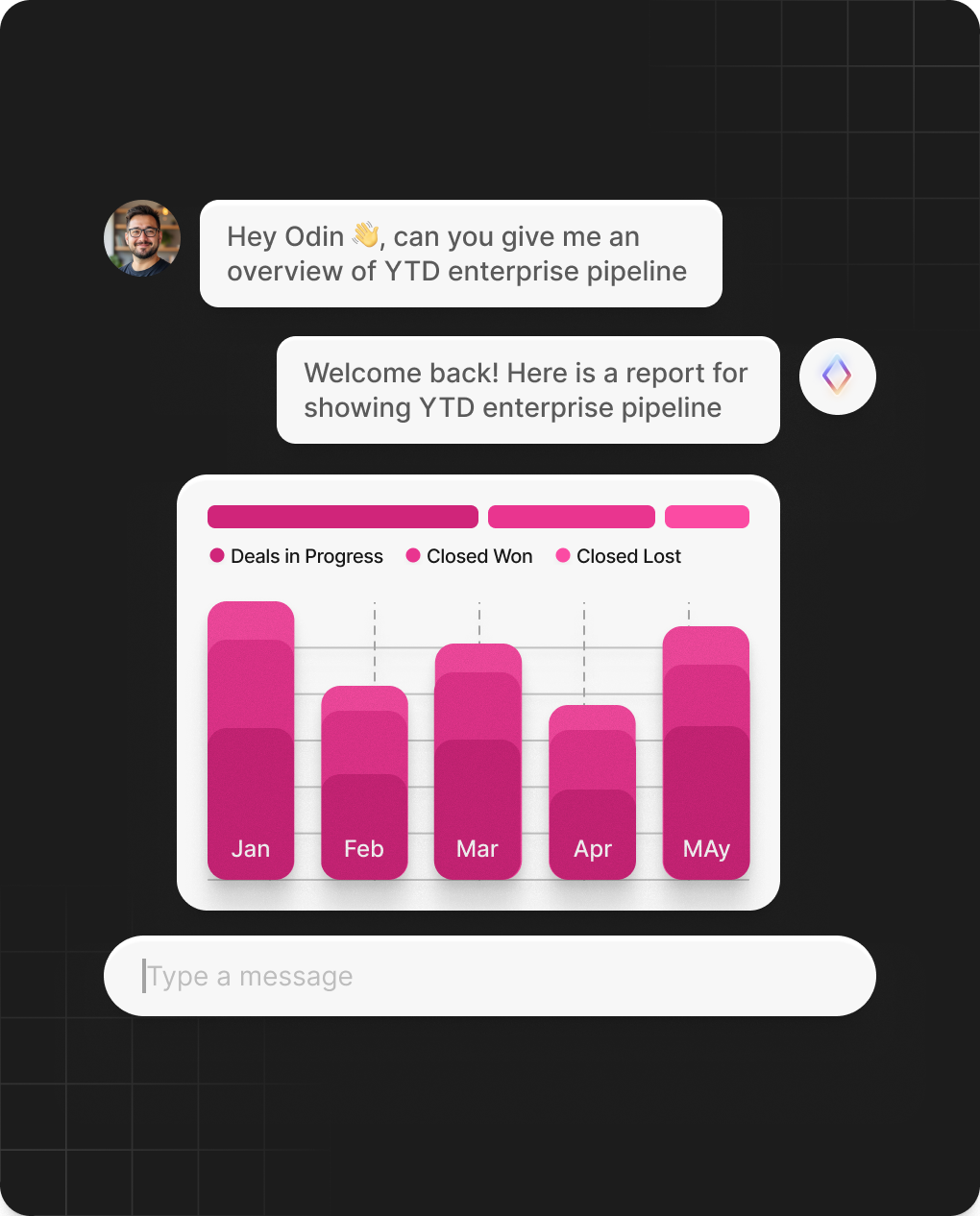
- Customizable dashboards & reporting: Offers flexible, no-code dashboards and report building capabilities, allowing teams to track any marketing KPI, visualize funnel performance, and analyze trends without relying on BI teams.
- Full-funnel journey analysis: Tracks complete user and account journeys across all touchpoints, enabling deep analysis of customer behavior, path analysis, and identification of key conversion points.
- Performance measurement & ROI: Provides robust tools for measuring campaign effectiveness, channel performance, and connecting marketing activities directly to pipeline and revenue outcomes through flexible multi-touch attribution models.
- Unified data foundation (Atlas): Automatically ingests, cleans, and unifies data from all GTM sources, ensuring analyses are based on a complete, accurate, and trustworthy dataset.
Why companies choose HockeyStack
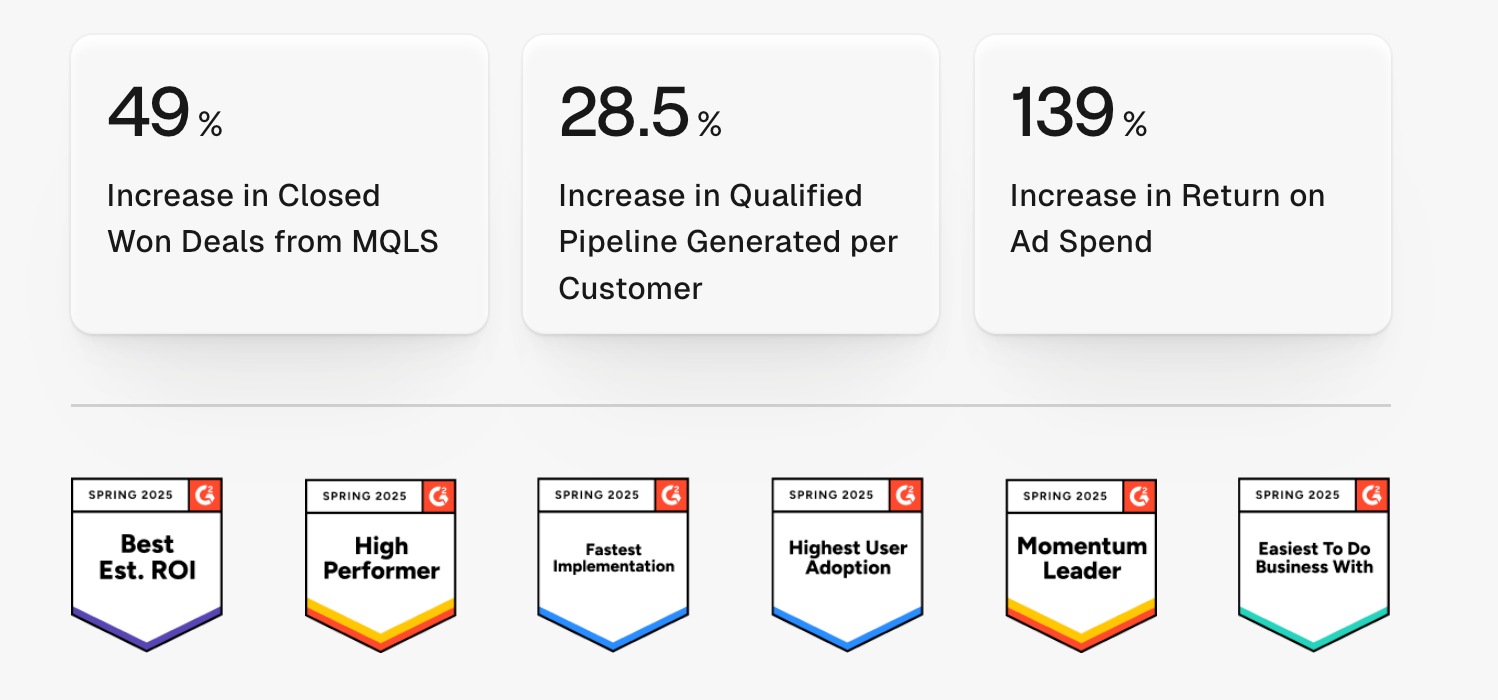
Customers choose HockeyStack because it moves beyond the limitations of traditional analytics tools, offering a unified, intelligent, and actionable platform designed specifically for the complexities of B2B GTM.
- A single source of truth for all GTM data. HockeyStack ends the chaos of scattered spreadsheets and disconnected dashboards by unifying marketing, sales, and revenue data in one place.
"With HockeyStack, we finally have the flexibility and visibility we lacked for years. Each marketer can create the views they need—without depending on BI or waiting weeks for answers.” — Lucía Delpozo, Head of Market Intelligence @ Kantox
- Clear, undeniable proof of marketing ROI. The platform connects every marketing activity directly to pipeline and revenue, enabling teams to finally prove their impact and make confident budget decisions.
"HockeyStack has been an incredible ROI product for us. It’s given us visibility into something we were completely blind to—what channels are working and where we should double down.” — Marty Kausas, Co-Founder & CEO @ Pylon
- AI-powered insights that accelerate decision-making. Odin, the AI Analyst, eliminates hours of manual reporting by answering complex performance questions in plain English, allowing teams to get insights and act faster.
“Odin is like having a teammate who can instantly analyze performance and recommend what to do next. I’ve used it to refine our media mix and forecast exactly what we need to hit our goals.” — Alex Schaefer, Marketing Operations at Honeycomb
- Alignment across the entire revenue team. By providing a shared, trustworthy view of performance and attribution, HockeyStack gets sales and marketing teams on the same page, focused on the same goals.
“HockeyStack gave us full-funnel visibility, scoring we trust, and attribution that shows what’s actually working. Sales and marketing are finally aligned, and we can make faster, more confident decisions.” — Hollie Lemos, VP Revenue Marketing @ Firstup
2. Ruler Analytics
Ruler Analytics is a marketing attribution and analytics platform focused on closing the loop between marketing activities and revenue. It specializes in tracking the entire customer journey, including phone calls and form fills, matching leads back to their original marketing source, and pushing conversion data into CRMs and analytics tools for comprehensive analysis.
Key features:
- CRM integration: It integrates with your CRM system (like Salesforce or HubSpot) and links marketing data with sales results.
- Call tracking: The platform assigns unique phone numbers to different marketing campaigns. This way, you can know exactly which marketing branch initiated the call.
- Closed-loop reporting: By combining data from marketing and sales, you get a full view of your ROI. For example, you can see that a Facebook ad led to a form submission, which became a sales lead and ultimately resulted in a purchase worth $5,000.
Limitations:
- Changing access rights is a bit cumbersome: Clients need to contact their account manager to simply change employee access rights. [See G2 Review]
- Reporting could be better: Users are satisfied with Ruler’s reporting tools, but they often turn to third-party apps for more detailed reports. [See G2 Review]
- Slower dashboard loading time when dealing with large datasets: When dealing with a larger number of leads, dashboard UI loading times tend to slow down. [See G2 Review]
Pricing:
Ruler Analytics offers tiered pricing based on the number of monthly website visits.
- For small businesses (up to 5,000 monthly visits), the cost starts at approximately $219 per month.
- For medium businesses (up to 50,000 monthly visits), it starts at around $715 per month. Large businesses (with up to 100,000 visits) pay $1,222 per month.
- For businesses with over 200,000 visits per month, there’s a custom pricing option available.
Web Analytics Platforms
Web analytics tools track and report on website traffic and user behavior. They measure key metrics like page views, sessions, bounce rates, traffic sources, and on-site conversions (like form fills). They are primarily used to understand how users find and interact with a company's website.
3. Google Analytics 4
Google Analytics 4 (GA4) is Google's next-generation analytics platform that helps marketers understand user behavior across websites and apps.
Unlike the previous model (Universal Analytics), GA4 uses machine learning insights, cross-platform tracking, and enhanced measurement to give you an all-rounded view of how customers engage with your content.
GA4’s user-centric reports and customizable dashboards are primarily used by marketing teams, product managers, and data analysts to get valuable insights and track performance over time.
Key features:
- Cross-platform tracking: The platform tracks user interactions across websites and apps to give you a unified view of customer journeys.
- Event-based data model: GA4’s event-driven tracking model gives you more flexibility and clearer insights compared to standard pageview tracking.
- Machine learning insights: Platforms’ built-in machine learning models can calculate advanced metrics like purchase and churn probability.
- Privacy-centric data collection: Control data collection to meet privacy regulations like GDPR and CCPA.
- Integration with Google Ads: Connects directly with Google Ads to optimize campaigns based on user behavior data from the website.
Limitations:
- Over-complicated updates: GA4 is getting increasingly difficult to understand and work with each update. [See G2 Review]
- Lacks basic reporting: GA4 no longer provides popular out-of-the-box reports, so you must manually create them or turn to third-party software. [See G2 Review]
- Difficult to transition to for marketers used to UA: Moving from Universal Analytics to GA4 has been a huge challenge for marketers. [See G2 Review]
This is just a glimpse of why marketers are exploring alternatives to Google Analytics 4.
Pricing
GA4 is free for most users and includes all the essential features you need for website and app analytics. For more advanced users, GA4 integrates with Google Analytics 360, which gives you higher data limits and dedicated support.
4. Matomo
Matomo is similar to Google Analytics 4 but with a big difference - you have full control over all your data because it's hosted on your servers.
Your visitor’s information isn’t shared with any other data broker, which makes it a perfect choice for privacy-oriented companies.
If you run a blog, Matomo can show you which articles are getting the most views, how visitors are finding your site, and how long they're staying on each page—and you own all of that data.
Key features:
- Full data ownership: You own all your data, so no third-party companies can access or control it.
- Privacy compliance: Matomo’s data ownership tools make sure that you comply with privacy laws like GDPR and CCPA.
- Customizable dashboards: You can set up personalized dashboards that show only the metrics that matter most to you.
- Heatmaps and session recordings: Matomo lets you visually track where users click and record sessions to understand their behavior.
Limitations:
- Complicated technical setup: Installing Matomo on your servers requires good IT knowledge, and Matomo should offer more help from the get-go. [See G2 Review]
- Filtering traffic isn’t intuitive: Users have mentioned that filtering out unwanted stats from specific IPs or bots could be made more straightforward. [See G2 Review]
- Slow performance with large data: Matomo tends to slow down when handling large volumes of data, which deters companies with bigger websites or high-traffic platforms. [See G2 Review]
Pricing
Matomo offers two main pricing options: a free version if you host it on your own servers and a cloud-hosted version that starts at around $21 per month, depending on the amount of traffic your site receives.
Product Analytics Platforms
Essential for software businesses, these platforms monitor how users interact with a digital product or application. They track feature adoption, user flows, engagement patterns, retention rates, and other in-app behaviors to provide insights for product development and user experience optimization.
5. Mixpanel
Mixpanel is a powerful product analytics platform that tracks user interactions with their digital products, primarily websites or mobile apps.
Companies use it to keep an eye on user behavior in real time and get insights into how users engage with their products, which features are popular, and where users drop off in the customer journey.
Mixpanel is particularly useful for product managers, marketers, and data analysts who need to understand user behavior patterns and improve product performance based on real-time data.
Top features:
- Advanced funnel data analysis: Visualize the steps users take within your product and see where they drop off to optimize conversions.
- Cohort analysis: Mixpanel groups your users based on their actions or habits so you can understand behavior patterns and target specific segments.
- Retention tracking: To improve user retention, you can monitor how often users return to your product over time.
- A/B testing: Mixpanel can test different product versions and compare results to find what works best for your offer.
Limitations:
- Persistent UI bugs: Users experience occasional UI bugs and data issues, and support rarely provides meaningful solutions. [See G2 Review]
- Complex navigation: The platform's interface can initially feel overwhelming, and you might need some time getting used to it. [See G2 Review]
- Less accurate for complex data: Mixpanel's ease of use can come at the cost of less accurate data or insufficient data analysis of complex datasets. [See G2 Review]
Pricing
Mixpanel offers a free plan that supports up to 20 million monthly events, which is ideal for personal projects.
The Growth plan starts at $24 per month, scales based on the number of events and offers more advanced features like saved reports and API access.
There’s also a custom plan for enterprises with additional features and premium support, but you’ll have to contact Mixpanel’s sales team to get an accurate quote.
6. Amplitude Analytics
Amplitude Analytics is another all-in-one product analytics software that organizations can leverage for deeper insights into user behavior across websites, mobile apps, and even connected devices.
Key features:
- User segmentation: Amplitude’s segmentation tool groups your users based on their behavior or traits to better target campaigns.
- Amplitude experiment: The platform lets you run tests (like A/B tests) to see how different changes affect user behavior, all within the same tool.
- Amplitude journeys: Amplitude shows you the full path users take through your product so you can see where they might get stuck or drop off and find ways to improve their experience.
- Impact analysis: Amplitude helps you measure the effects of product changes—like adding a new feature—on key metrics so you can see what’s working and what’s not.
Limitations:
- Complicated for beginners: The platform’s reporting tools are quite complex and might not be the best fit for junior managers and marketers. [See G2 Review]
- Prone to bugs: Amplitude’s dev team releases constant updates and new features, which usually leads to glitches with existing tools. [See G2 Review]
- Hard to implement: Amplitude’s complexity makes it hard to implement in the beginning, especially if you have a smaller IT team. [See G2 Review]
Pricing
Amplitude has four pricing plans available:
- Starter plan: Free-to-use tier created for individuals and beginners. Gives you basic analytics tools.
- Plus plan: Starts at $49/mo, built for smaller, boot-strapped marketing teams.
- Growth plan: The growth plan has everything in Plus with some more advanced features. Contact Amplitude’s sales teams for custom pricing.
- Enterprise plan: Expands Growth plan with larger throughputs for larger companies. Contact Amplitude for an exact quote.
Marketing Automation Hubs (with Analytics)
These platforms primarily automate marketing tasks like email campaigns, lead nurturing, and landing page creation. They include built-in analytics modules designed to report on the performance of the activities managed within the platform itself, such as email open rates or form submission counts.
7. HubSpot Marketing Hub
HubSpot Marketing Hub is an all-in-one marketing platform built to help businesses attract and engage customers through a suite of marketing tools.
With analysis tools for email marketing, social media management, content creation, SEO optimization, and more, Marketing Hub helps you build and manage any type of digital campaign.
It’s perfect for marketers, sales teams, and business owners who want to manage multiple marketing channels—such as email campaigns, social media, and SEO—all from a single platform.
Key features:
- All-in-one marketing platform: You can track every step of your sales funnel from one centralized interface.
- Social media scheduling: Gives you the option to schedule and publish social media posts directly from the platform.
- Customizable reporting: The platform gives you custom reports to track campaign performance and visualize key metrics for your marketing strategy.
- Landing page builder: You can create landing pages with easy-to-use templates and a drag-and-drop editor.
Limitations:
- Selling to unsuitable customers: HubSpot sometimes offers and sells advanced features to customers who won’t extract real value. [See G2 Review]
- Constant updates: HubSpot frequently updates its software, which can lead to unexpected changes that require time to adjust. [See G2 Review]
- Advanced features pricing: HubSpot's advanced features come with a large price gap. [See G2 Review]
Pricing
HubSpot has three main pricing plans:
- Starter plan: Starts at €15 per month per seat.
- Professional plan: Starts at €792 per month, includes 3 seats, with additional seats available for €45 per month.
- Enterprise plan: Starts at €3,300 per month, includes 5 seats, with extra seats priced at €75 per month.
8. Salesforce Marketing Cloud Intelligence
Salesforce Marketing Cloud Intelligence (formerly Datorama) is a marketing analytics platform that combines data from multiple sources to better understand the direct impact of each marketing dollar spent.
The platform uses data harmonization to standardize incoming data into one consistent format. For example, a digital marketing manager can analyze how leads from Facebook convert compared to those from Google Ads without spending hours on data cleaning.
Key features:
- Einstein AI: Salesforce’s Einstein AI can analyze your marketing data and generate predictive insights to improve your campaign performance.
- Data stream management: You can unify data streams from multiple sources to keep your marketing data accurate and up-to-date.
- Marketing intelligence connectors: Pre-built connectors let you connect easily with advertising platforms, social media, and CRM systems.
- Multi-touch attribution: You can track conversions across all touchpoints to clearly see how each channel contributes to your results.
- Custom metrics and KPIs: Define and track custom metrics specific to your strategy so you can measure what matters most.
Limitations:
- Outdated UI/UX: Many users feel that the platform could use an update of UI/UX. [See G2 Review]
- Long loading time: Some users have reported that Salesforce’s system tends to get slower loading times occasionally. [See G2 Review]
- Bad reporting tools: Customers said that Salesforce couldn’t even deliver basic accurate reports despite the long setups and thousands of dollars invested. [See G2 Review]
Pricing
Salesforce pricing is divided into three tiers.
- Starter plan: At $3,000/month, you get access to 10 users and 3 million data rows.
- Growth plan: $10,000/month gets you access to 20 users and 20 million data rows.
- Plus plan: This tier gives you access to up to 80 users and over 100 million data rows, but you’ll have to contact their sales team to get an accurate quote.
Business Intelligence (BI) Tools
These are general-purpose analytics platforms that allow users to connect to a wide variety of data sources across an entire organization (including, but not limited to, marketing data). They offer flexible tools for creating custom dashboards, reports, and complex data visualizations, typically requiring specialized analytical skills to operate effectively.
9. Tableau
Tableau is a data visualization and business intelligence tool that helps organizations analyze, visualize, and share insights from their data in an intuitive format.
Users can connect to a wide range of data sources, including databases, spreadsheets, and cloud services, and then transform that data into interactive dashboards, graphs, and reports.
It's especially useful for tasks such as performance tracking, sales analysis, and customer segmentation. It also features a VizQL (Visual Query Language) engine that instantly translates drag-and-drop actions into data queries, which eliminates the need for any complex SQL queries.
Key features:
- Ask Data feature: You can ask questions about your data in plain language, and Tableau will generate visualizations to help you find insights easily.
- Tableau Prep: Tableau’s Prep tool helps you clean and prepare data for analysis automatically.
- VizQL technology: Tableau uses VizQL to turn your actions into visualizations, without any written queries on your side.
- Storytelling with data: You can combine different visualizations to create data stories and share what you found with stakeholders more easily.
- Tableau Server and Tableau Online: Tableau Server and Online tools let you share dashboards securely across your company.
Limitations:
- Limited built-in charts: Unlike competitors, Tableau offers only 24 built-in charts, so users often need to manually create additional visualizations. [See G2 Review]
- Slow performance with large datasets: Users often complained about Tableau’s slow loading times when working with larger datasets. [See G2 Review]
- High entry cost: The high starting price of Tableau turns away smaller businesses and individual users. [See G2 Review]
Pricing
Tableau offers two-tiered pricing models for regular users and enterprises.
For individual users, the Tableau Creator plan starts at $75/month.
Teams and companies can choose either Tableau Explorer at $42 per user per month or Tableau Viewer at $15 per user per month.
10. Domo
Domo is a business intelligence software that’s primarily built for managers, data analysts, and CEOs who need a clear and up-to-date picture of what's happening in their company.
Instead of juggling multiple spreadsheets and software tools, Domo connects to various data sources like databases, social media, sales systems, and marketing platforms.
It can pull in sales figures from your CRM, website analytics, and social media engagement stats and display them on interactive dashboards.
Key features:
- Easy data connections: Domo brings together information from hundreds of different places so you can see everything about your business all at once.
- Team collaboration tools: You and your team can share reports and findings through a built-in collaboration tool.
- Predictive AI: The platform uses robust AI to spot patterns, opportunities, and risks hidden in your data.
Limitations:
- Slow customer support: Users reported that Domo’s support needs a lot of time to respond to and solve tickets. [See G2 Review]
- Lack of features: Domo misses some of the features that other BI platforms have, like advanced reporting customization. [See G2 Review]
- Interface bugs: Customers often come across minor glitches and slow loading times with Domo. [See G2 Review]
Pricing
Domo’s pricing isn’t listed directly on their site because it’s based on the consumption model.
Generally, it’s known to be on the higher end, but they do offer a free trial so you can test the platform before committing.
Channel-Specific Analytics Tools
These are specialized tools designed to provide deep analysis of performance within a single marketing channel. Examples include platforms focused exclusively on SEO performance analysis, social media engagement tracking, or call analytics. They offer granular data for optimizing specific channel tactics but do not provide a cross-channel view.
11. Semrush
Semrush is an industry-leading marketing platform that companies use to track keyword rankings, analyze competitor strategies, and optimize their websites for better search engine optimization.
The platform is particularly useful for SEO specialists, content marketers, and digital agencies who need data-driven strategies to refine their content and drive more traffic.
Key features:
- Keyword research: You can find keywords to target for SEO and PPC campaigns and drive more traffic to your site.
- Competitor analysis: Semrush analyzes what and how your competitors are doing.
- Site audit: The platform can run audits on your website to locate and fix SEO problems that are affecting your rankings.
- Social media strategy management: You can schedule, publish, and monitor your social media posts to keep your online presence consistent.
Limitations:
- High cost: One of the most common user complaints with Semrush is the higher price compared to its direct competitors. [See G2 Review]
- Limited training resources: Users reported that the training materials could be better and would prefer simpler, easy-to-follow guides. [See G2 Review]
- Account manager limitations: The assigned account managers usually don’t have enough knowledge about the product and just point you to tutorial videos for complex questions. [See G2 Review]
Pricing
Semrush doesn’t have a free plan but offers a free trial.
- Pro plan: starts at $139.95 per month.
- Guru plan: costs $249.95 a month.
- Business plan: available at $499.95 per month.
Each plan scales based on the size of your team and the needs of your campaigns, with additional tools for content marketing, SEO, and competitor analysis.
12. Sprout Social
Sprout Social is a powerful social media analytics platform that streamlines how you plan, publish, engage, and analyze content across social networks like Facebook, Twitter, Instagram, LinkedIn, and Pinterest.
Key features:
- Smart inbox: A unified inbox that gathers all your social media messages and comments from different platforms into one place for easy management.
- Social listening tools: The platform lets you monitor specific keywords, hashtags, and brand mentions to understand audience sentiment and trending topics.
- Social CRM integration: Connects social media platform interactions with your customer relationship management system to track and nurture relationships.
- Chatbot and automation tools: You can use and create automated chatbots to complete different tasks.
Limitations:
- The platform can disconnect out of the blue: Some users complained that their profile gets disconnected out of the blue. [See G2 Review]
- Lack of advanced features: Users would like to see the option to discover creators that didn’t mention them, similar to Ahrefs’ tool for backlinking. [See G2 Review]
- Poor performance when multiple members are active: The platform slows down occasionally, especially when more team members try to work at the same time. [See G2 Review]
Pricing
Sprout Social has four pricing plans.
The Standard plan is $199/seat/month and is primarily targeted towards smaller teams.
The Professional plan costs $299/seat/month and is designed for teams that manage multiple profiles.
The Advanced plan, at $399/seat/month, includes more sophisticated tools like AI features and message alerts. There’s also the Enterprise plan with custom pricing.
Honorable Mentions
Beyond the core platforms, several specialized marketing tools offer deep analytics for specific niches or functions. While they might not provide the full GTM picture, they can be powerful additions for certain use cases:
- CleverTap: A customer engagement and retention platform primarily focused on mobile apps. It uses analytics to understand user behavior within the app and optimize the customer experience through targeted messaging and campaigns.
- Supermetrics: Acts as a data connector, pulling marketing data from various sources (like ad platforms and social media) into reporting destinations like Google Sheets, Excel, Looker Studio, or even a data warehouse. It simplifies data aggregation but doesn't perform the deep analysis itself.
- TripleWhale: An analytics and attribution platform built specifically for the ecommerce businessess (particularly Shopify brands). It focuses on tracking ad performance (ROAS), customer acquisition costs, and lifetime value for online stores.
- Heap Analytics: A web and mobile analytics tool known for its "autocapture" feature, automatically tracking all user interactions without manual event setup. This can simplify data collection, especially for teams analyzing complex user flows or dealing with big data volumes.
Unify Your Marketing Data & Amplify Your Revenue Impact
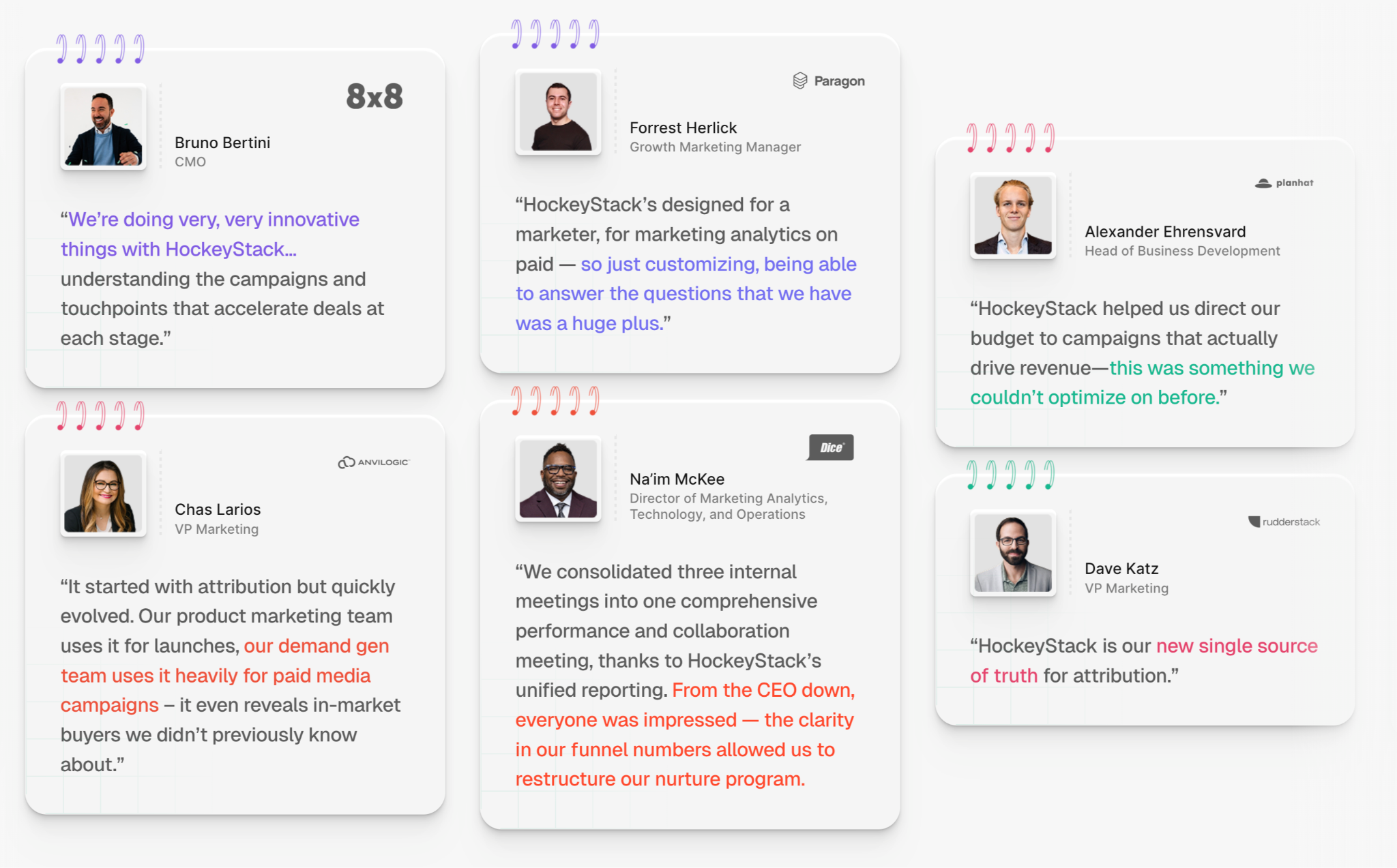
HockeyStack is more than just a marketing data analytics solution—it’s the all-in-one GTM AI platform designed to help B2B companies optimize their entire marketing funnel.
Our platform offers powerful features like end-to-end attribution, customizable dashboards, and in-depth customer journey mapping so you can finally transform complex data into clear, actionable insights.
Whether you’re looking to improve marketing ROI, track the customer journey with precision, or unify your data across platforms, HockeyStack has you covered.
With easy-to-use, no-code integrations and exceptional customer support, you’ll be up and running quickly—ready to drive real, measurable results.
So, why settle for less when you can have the best?
Book a demo today and experience firsthand how much easier marketing gets with HockeyStack by your side.
FAQs
What are marketing analytics platforms?
Marketing analytics platforms are tools that help businesses monitor and analyze their marketing performance across various channels. They provide insights into campaign effectiveness, customer behavior, and ROI so marketers can optimize their strategies based on actual data.
What are the different types of marketing analytics tools?
There are several types of marketing analytics and their corresponding tools:
- Web analytics tools (e.g., Google Analytics) that track website traffic and user behavior.
- Attribution tools (e.g., HockeyStack) that measure the impact of marketing touchpoints on conversions.
- CRM analytics tools (e.g., HubSpot) that analyze customer data and engagement across the sales funnel.
- Social media analytics tools (e.g., Sprout Social) that monitor social performance and engagement.
- Business intelligence tools (e.g., Tableau) that aggregate and visualize large sets of marketing and business data.
- Marketing automation tools (e.g., Marketo) that automate tasks like email marketing, lead nurturing, and campaign tracking.
How do these platforms actually connect marketing efforts to revenue?
They do it by breaking down data silos. A true GTM intelligence platform connects to your CRM, ad platforms, and website analytics. It stitches together the full customer journey, tracking every touchpoint. Then, using attribution modeling, it shows you exactly how specific marketing efforts—like a blog post read three months ago—contributed to a deal closing today. This moves beyond disconnected channel metrics to provide a clear, unified view of ROI.
What's the real difference between a GTM Intelligence platform and just using my CRM's reports?
Your CRM only sees the final chapters of the story—the sales activities. It has almost zero visibility into the marketing journey that happened before a lead became an opportunity. A GTM AI platform unifies both marketing and sales data. This means it can show you the entire journey, revealing how different marketing campaigns influenced deals long before they ever showed up in the CRM pipeline report.
14 Best GA4 Alternatives & Competitors on the Market Today
Tired of GA4? Who isn't. Check out 14 powerful alternatives for B2B marketing. Explore top features, advantages, limitations, and pricing.

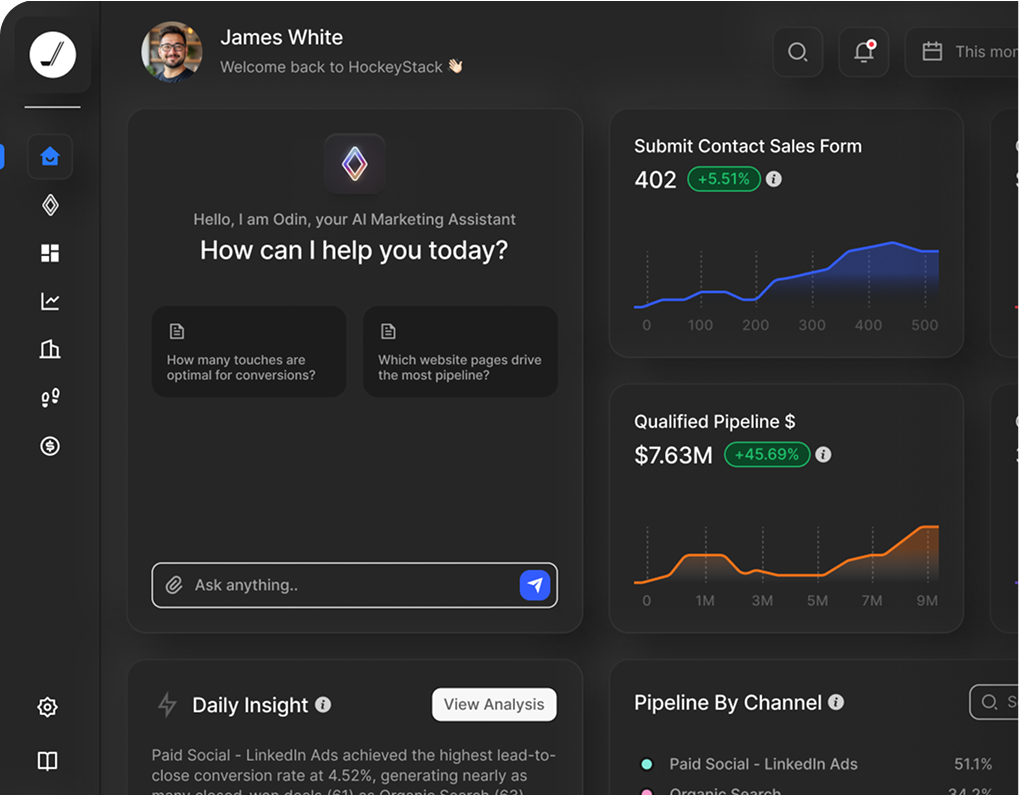
Ready to see HockeyStack in action?
HockeyStack turns all of your online and offline GTM data into visual buyer journeys and dashboards, AI-powered recommendations, and the industry’s best-performing account and lead scoring.

Ready to See HockeyStack in Action?
HockeyStack turns all of your online and offline GTM data into visual buyer journeys and dashboards, AI-powered recommendations, and the industry’s best-performing account and lead scoring.




